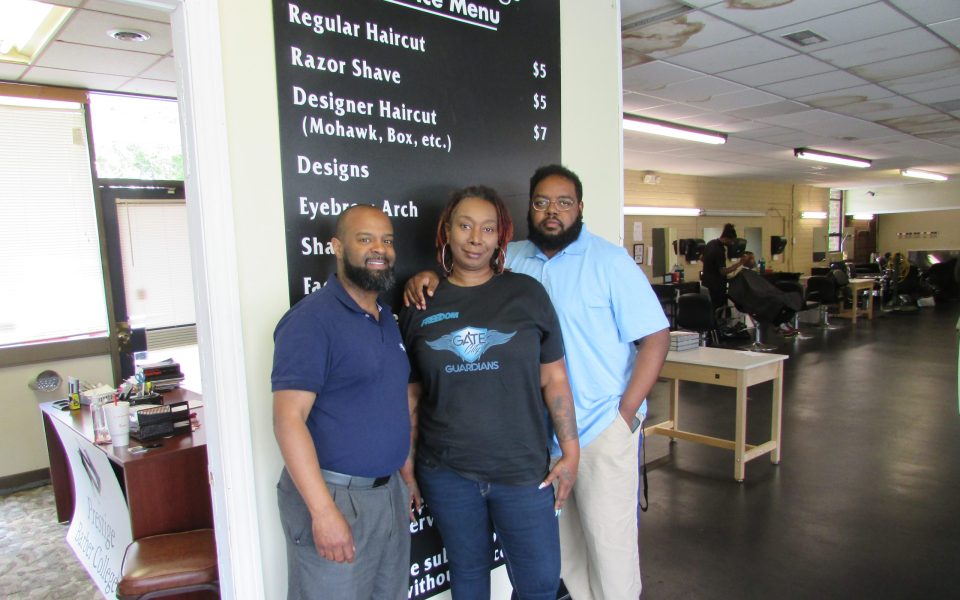“A lot of the homicides, we find out faster than the news,” said Ingram Bell. “We have the intel. We go talk to the families of people of have been shot.”
As a victim of gun violence herself, Bell can relate to people who are hurting from violence, and even considering responding in kind. In 2011, she was shot in the head by a group of men who intended the bullets for her then-boyfriend.
Using a public-health model to address violence by sending out credible messengers to talk people who are ready to hurt someone off the ledge, Bell has been working with a core group of six people over the past 12 months. Her role, as conceived by the national organization Cure Violence, is “interrupter.” The local program, known as Gate City Guardians, includes a Mothers of the Victims group that meets every Thursday, and a grievance team that reaches out to families of victims immediately after a shooting to offer support. If the team finds that a family member or friend is considering retaliation, that sets the stage for an interrupter to talk them down.
Gene Blackmon, one of the core members, said Gate City Guardians is also working with UNCG to set up a community dialogue on violence, and members are trying to work out a ceasefire among two opposing groups. He didn’t want to identify the parties out of concern that publicizing them will betray their confidence. Likewise, the volunteer workers don’t share any of the tips they receive with the police. If information shared with interrupters was passed on to the police, it could result in someone getting killed, Bell said.
The members of the core group tap a network of community allies as needed, Blackmon said. As an example, he mentioned two men they’re working with to provide summer landscaping jobs as a diversion for individuals considered to be at high risk for committing violence.
As it turns out, the Gate City Guardians have some competition.
On Tuesday, members of Greensboro City Council and the Guilford County Commission met in a large conference room in the old BB&T Building to consider a proposal to jointly fund a program based on the Cure Violence model through a $406,804 allocation with the cost split down the middle by the two governments. Based on the consensus of a working group of four city council members and four commissioners who have been meeting over the past 18 months, the proposed memorandum of agreement identifies One Step Further, a nonprofit headed by Mayor Pro Tem Yvonne Johnson, as the agency to run the program. Johnson informed her fellow elected officials that the city-county partnership will be named — wait for it — Gate City Coalition.
Addressing the potential perception of a conflict of interest, Johnson said she will abstain from voting on the contract, and will not take any money from the contract, with the exception of reimbursement for travel to visit other cities and study their efforts.
Bell and Blackmon did not attend the joint meeting of the city council and county commission on Tuesday.
“We’re trying to find our own funding,” Bell said of their endeavor, which to date has operated out of pocket or through small donations. “We no longer desire to work with the city and the county since they hijacked the program.”
Mayor Nancy Vaughan said she doesn’t know why Bell and Blackmon’s group wound up parting ways with the city-county partnership.
“Most of [the discussion] was really the administration of the program and getting the contracts together and figuring out how the nonprofit was going to be run,” Vaughan said. “It wasn’t really dealing with who the interrupters were going to be or who was going to be hired, so we weren’t even talking about who was going to implement, well, aside from One Step Further.”
The advantage of Bell and Blackmon’s community startup is that it didn’t require local government approval to launch immediately, and Vaughan acknowledged “this has taken way longer than I anticipated.”
During the joint meeting on Tuesday, city council members and county commissioners squabbled over whether they would vote on the contract as a single body or have each governing body consider resolutions separately. Ultimately, Alan Branson, the chairman of the county commission, suggested the county manager and city manager confer to find a time for the two governing bodies to meet again sometime in the next three to four weeks.
To her credit, Johnson demonstrated that she understands that for the interrupters to gain trust in the community and be effective in their work, the program has to maintain autonomy from the police.
Councilwoman Marikay Abuzuaiter asked Johnson: “If the interrupters heard about something that might happen, would they be notifying the police?”
Johnson responded, “No, they would go there and try to interrupt it.”
Councilwoman Sharon Hightower, an early champion of the Cure Violence model, addressed the elephant in the room: In poor, predominantly non-white communities, the police are not always regarded as a resource, and are often considered a liability.
“Just to be clear, the community don’t want to be seen as snitches,” Hightower said. “That’s why you don’t have them working closely. This is not a police program. This is separate and apart because you’re attempting to gain trust of those who sometimes know more than all of us know, and direct and guide them to where they need to interrupt, or even reach out in the community. Sometimes they will show up at hospitals in instances. They need to have full trust in who they’re interacting with. You may put yourself in a precarious situation.”
Bell and Blackmon said they don’t see any reason why the two programs — Gate City Guardians and Gate City Coalition — can’t coexist. Johnson announced that her program has chosen Smith Homes and an area bounded by Martin Luther King Jr. Drive, Benjamin Benson Street, Bragg Street and Julian Street as its two target areas. Afterwards, Bell said it made sense to her that the two programs would focus on different geographies. And she noted that the Cure Violence organization identified the Merritt Drive corridor as having the highest number of homicides and assaults in an assessment report completed for the city last year. So, it’s not as if there aren’t enough trouble spots in the city to go around.
But Bell isn’t shy about saying she believes her program holds an advantage over the official effort that the city and county are currently trying to work out.
“Those of us that are working on the ground have been involved in community,” she said. “I’ve been shot in the head. The fact that I’m willing to do the work is a definite plus.”
Join the First Amendment Society, a membership that goes directly to funding TCB‘s newsroom.
We believe that reporting can save the world.
The TCB First Amendment Society recognizes the vital role of a free, unfettered press with a bundling of local experiences designed to build community, and unique engagements with our newsroom that will help you understand, and shape, local journalism’s critical role in uplifting the people in our cities.
All revenue goes directly into the newsroom as reporters’ salaries and freelance commissions.





Leave a Reply